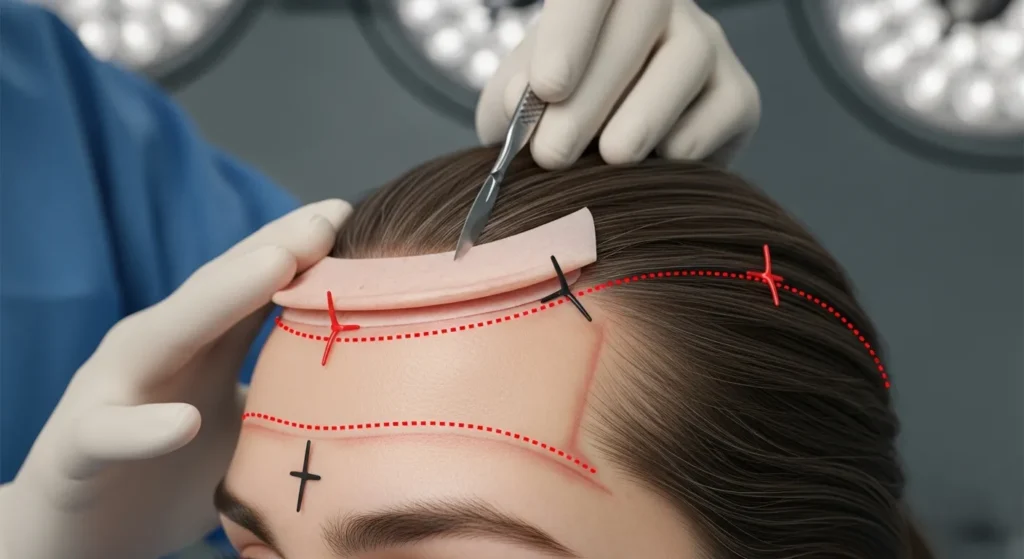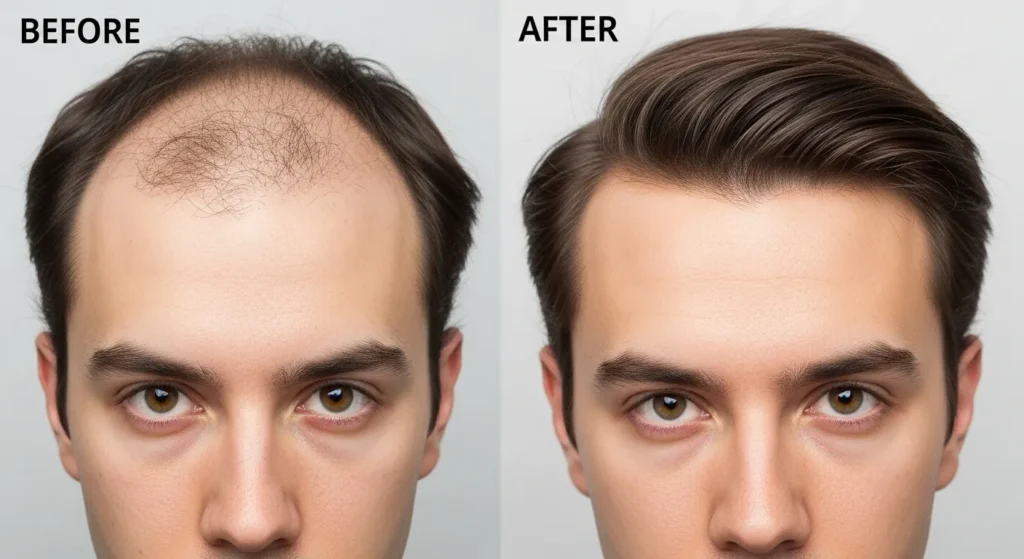Do you feel self-conscious about a high forehead or receding hairline? Hairline-lowering surgery South Africa offers a medically approved, permanent solution, bringing your hairline forward to enhance facial harmony and boost confidence.
This comprehensive guide explores how the procedure works, local cost breakdowns, expert surgical methods, recovery timelines, and what to expect from top South African clinics. Whether you’re a local resident or a medical tourist, you’ll find trusted, experience-based answers here to help you make an informed decision.
What Is Hairline Lowering Surgery?

Hairline lowering surgery, also known as forehead reduction or scalp advancement surgery, is a cosmetic procedure that reduces the size of the forehead by surgically advancing the hairline. It creates better facial proportions and is often used by women with genetically high hairlines or by patients undergoing facial feminization surgery (FFS).
How It Works
- A trichophytic or zig-zag incision is made along the natural hairline.
- The scalp is loosened and advanced forward.
- Excess forehead skin is removed, and the incision is closed to hide the scar within the hairline.
Who Is a Good Candidate?
- Individuals with a naturally high hairline
- Good scalp flexibility (laxity)
- No significant hair thinning or loss in the frontal area
- Both men and women, though stability of the hairline is crucial in males
Hairline Lowering Surgery South Africa: why choose South africa
South Africa is becoming a popular destination for cosmetic surgery due to its cost-effective pricing, world-class medical expertise, and state-of-the-art clinics.
Cost Comparison
Compared to the UK, Turkey, or the US, South Africa offers:
- Lower surgical fees
- Affordable recovery accommodations
- Access to board-certified plastic surgeons
Example: Forehead reduction in the US may cost $7,000–$10,000. In South Africa, the price ranges between R30,000 and R50,000 (approx. $1,600–$2,600).
Clinic & Surgeon Credentials
- HPCSA (Health Professions Council of South Africa) registration is mandatory.
- Many surgeons are internationally trained and members of global societies.
- Look for JCI-accredited or ISO-certified clinics.
Medical Tourism Perks
- Private hospital suites
- Post-surgical retreat packages
- Multilingual staff and visa support for international patients
Step-by-Step Procedure Breakdown
Pre-Op Consultation
- Medical history review
- Hairline mapping and scalp laxity evaluation
- Planning for incision type and potential scar concealment
Surgical Techniques
- Most common: Trichophytic incision – promotes hair growth through the scar
- Zig-zag incision – used to break linear scar visibility
- Some surgeons use tissue expansion if more than 2.5–3 cm advancement is needed
Anesthesia & Duration
- Performed under general anesthesia
- Surgery lasts 2 to 3 hours, depending on complexity
Optional Techniques
- Balloon expanders for those with tight scalps
- Combination with brow lift for enhanced results
Cost & Financing in South Africa
What’s Included
- Consultation
- Surgical fees
- Anesthesia
- Operating room and hospital stay
- Post-op follow-ups
Typical Price Range
- R30,000–R50,000 depending on clinic, surgeon experience, and extras
- Additional procedures (like brow lift) may increase costs
Payment Options
- Most clinics offer payment plans
- Medical tourism packages with accommodation, transport, and aftercare
Recovery Timeline & Aftercare
Immediately After Surgery
- Mild swelling, bruising, and tightness around the forehead
- Incision will be bandaged; pain is generally mild
Week 1–2
- Stitches removed around Day 7–10
- Patients can return to non-strenuous work
- Avoid heavy exercise, hair washing, or sun exposure
Month 1–3
- Numbness may persist temporarily
- Hair begins to grow through the incision area
- Scar starts blending into the hairline
Month 3–6
- Final results become visible
- Most patients report satisfaction with hairline symmetry and fullness
Risks, Complications & How to Avoid Them
Common Side Effects
- Swelling, numbness, and tightness
- Visible or hypertrophic scarring in rare cases
- Temporary shock hair loss near incision site
Less Common Risks
- Infection
- Asymmetrical results
- Hair thinning along the scar line (usually temporary)
How to Avoid Complications
- Choose a surgeon with extensive experience in hairline work
- Follow post-op care instructions strictly
- Avoid early exercise or applying tension to the incision site
Alternatives & Combined Procedures
Hair Transplant vs Hairline Lowering
| Feature | Hair Transplant | Hairline Lowering |
|---|---|---|
| Ideal For | Thinning hair | High forehead |
| Duration | Multi-sessions | One-time surgery |
| Cost | Variable | Fixed |
| Scar | Minimal | Along hairline |
Other Combined Procedures
- Brow lift (for aging-related drooping)
- FFS (facial feminization surgery)
- Scar revision, if needed later
Choosing the Right Surgeon and Clinic
Credentials Checklist
✅ HPCSA-registered
✅ Specializes in hairline or craniofacial surgery
✅ Provides before & after gallery
✅ International training or board certification
Consultation Questions
- What technique do you use?
- How many cases have you performed?
- Can I see real patient outcomes?
Red Flags to Avoid
- No scar management plan
- Unrealistic promises
- No medical license or vague online presence

FAQs
Can men undergo hairline lowering?
Yes, but only if their hairline is stable and there’s no active male pattern baldness.
How far can the hairline be advanced?
Typically, 2 to 3 cm depending on scalp laxity.
How long should I stay in South Africa post-surgery?
Plan for 7–10 days to allow for healing and suture removal.
When can I wash my hair?
After 5–7 days, depending on surgeon’s instructions.
Will the scar be visible?
Usually no. Techniques like trichophytic closure promote hair growth through the scar line, camouflaging it effectively.
Take Your Next Step
Looking for a safe, affordable, and expert-led procedure? Book a consultation with our South African hairline lowering specialists today. Whether you’re a local patient or traveling for medical care, we’ll help you plan every step—from evaluation to recovery.
